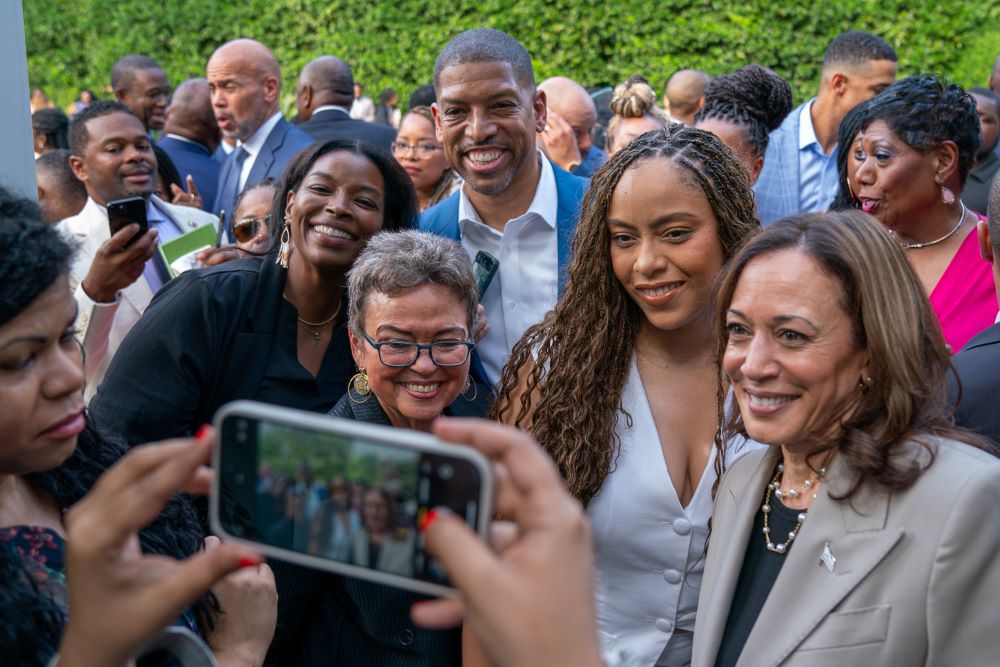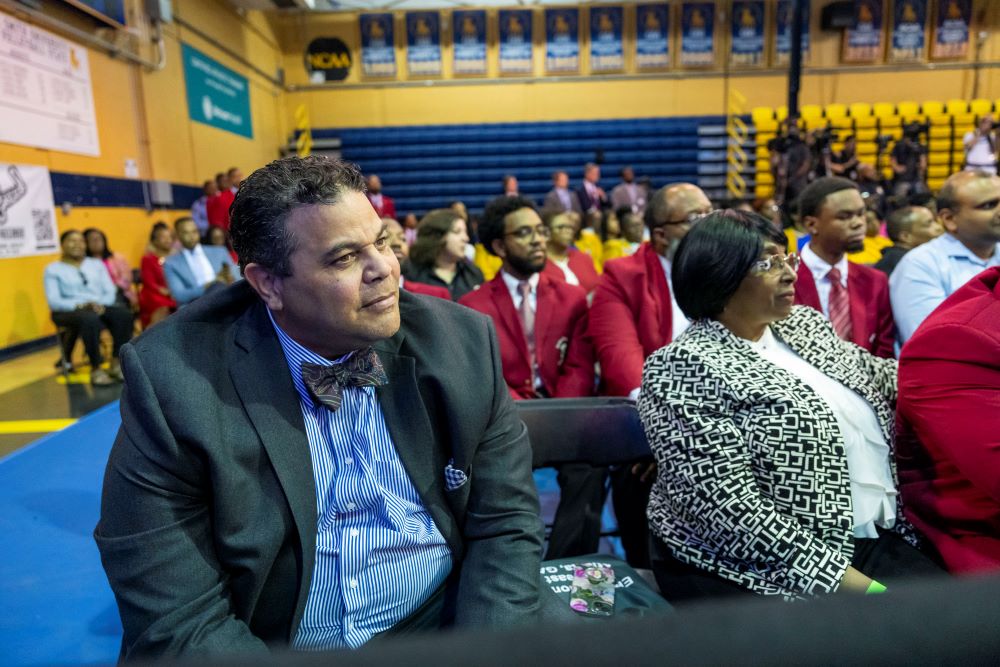
Vice President Kamala Harris poses for a photo with guests at a reception for Black business leaders July 18 at the vice president’s residence in Washington, D.C. (Official White House photo/Polly Irungu)
The Democrats left Chicago feeling good. The convention had delivered an upbeat and unified party. Vice President Kamala Harris and Gov. Tim Walz gave fine acceptance speeches. The ghosts of 1968 were banished and the Democrats felt that they had the wind at their back.
Hurdles remain, actually one hurdle: working-class voters. Let's start with Luzerne County, Pennsylvania. Back in 2008, when I was still writing for America magazine, I called attention to Luzerne County in a post on the morrow of President Barack Obama's historic victory, noting that Obama had carried the northeastern Pennsylvania county with 54% of the vote, up from John Kerry's 51% in 2004. Hazleton, a city in Luzerne County, had passed an anti-immigrant ordinance in 2006. The town's mayor, Lou Barletta, would become one of the faces of the Tea Party movement when he won a seat in Congress in 2010, defeating longtime Democratic Rep. Paul Kanjorski.
Luzerne has changed and Hazleton is now a majority minority city, with Latinos constituting more than 60% of the population. The growth of the Latino vote, however, has not translated into Democratic wins. Politico reports:
Nicarol Soto, a Democrat who lost a city council bid in Hazleton last year, says she's seen it in her own family, where some identify as Donald Trump supporters. "We are losing a lot of voters," said Soto, a Dominican Republic-born resident who immigrated with her family to Hazleton during her high school years. She attributes some of the rightward shift to economic concerns and attitudes on cultural issues like abortion. "They're moving towards the other side."
According to Politico, former President Donald Trump improved his vote totals in 2020 significantly in both Allentown and Reading, towns that are heavily Latino but which also lean more Democratic.
Democrats have a problem with working-class voters. Jason Willick wrote about the "diploma divide" in The Washington Post last year and Doug Sosnik analyzed it in The New York Times. "The confluence of rising globalization, technological developments and the offshoring of many working-class jobs led to a sorting of economic fortunes, a widening gap in the average real wealth between households led by college graduates compared with the rest of the population, whose levels are near all-time lows," Sosnik wrote. He also noted that in the seven battleground states "education levels are near the national average — not proportionately highly educated nor toward the bottom of attainment."
That is why policies like forgiving student debt are so politically stupid — and morally questionable. Why should working-class taxpayers, whose wealth is at all-time lows, pay for the education of those who have prospered in the information economy? And before taxpayers start footing the bill for college, someone needs to demand accountability for why the cost of college has skyrocketed.
The feel-good vibes coming out of the Democratic convention are running into the strong headwinds of culturally conservative working-class voters.
An historian friend reminded me that Democrats started losing the working class when Richard Nixon adopted his "southern strategy" in 1968, a racially divisive message that aimed to attract northern white working-class voters as well as southerners. Certainly, there is a through line from Nixon's 1968 campaign to George Wallace winning the Michigan Democratic primary in 1972, to Pat Buchanan's populist campaign in 1992, to the tea party, to Donald Trump today. But, Trump's ability to improve his numbers among Black and Latino working-class voters indicates that class and educational attainment, not race, are the more powerful determinants of voting patterns today.
Democrats, especially Harris, need to show that they care about these working-class voters and have some policy ideas that will help them. During the DNC, a friend with a long background working with organized labor and the Catholic Church, sent me a note.
It read, in part, "I spent yesterday driving around the 'THUMB' region of Michigan — and all day long was thinking about the people living at the end of gravel roads in trailer parks (to quote Msgr. Frank Koper, former rector of the Polish Seminary in Orchard Lake) ... of towns where the young people leave for decent paying jobs somewhere else … The lack of transportation options for people, the lack of mental health services … (to say nothing of the non-voters working on dairy farms, etc.)." He noted that I had referred to Robert Kennedy — pere, not fils — and added, "my wife talked this AM of RFK's tour of West Virginia, the outposts, the outcasts (Hillary's 'deplorables') — the Dems, Harris, need to do something like Bobby's tour to soften the lines between us and them. … To show the other side of America."
That is good advice, and Harris should take it, both for winning the election and governing if she wins. Working-class voters remember when they were called "deplorables" by the Democratic nominee in 2016, just as they remember her husband signing NAFTA, which shipped many jobs overseas. It confirmed what they suspected: that cultural elites really do look down on them. It is difficult to overstate the sense of betrayal and hostility lifelong Democrats felt by the end of the Clinton family's leadership of the party.
Latest CNN polls show that a surprisingly large number of people report they could yet change their mind. That is Harris' biggest opportunity: These voters know everything there is to know about Trump. They continue to report that they think he would do a better job on the economy than Harris would. Her entry to them is the question: Who do you think cares about people like you? But then she has to show that she actually cares, that she wants to listen to working-class voters, not only talk to them or about them. Hillary Clinton thought the election was about her breaking the glass ceiling, and look how that turned out. Harris needs to convince voters she wants to help them break whatever glass ceilings they face. That is how to rebuild the famous "blue wall" of Democratic states along the Great Lakes, a wall that came crashing down in 2016.

Guests attend a moderated conversation with Vice President Kamala Harris, actor Michael Ealy and former State Rep. Bakari Sellers at Johnson C. Smith University in Charlotte, North Carolina June 12 as part of Harris' Economic Opportunity Tour. (Official White House photo/Yash Mori)
In addition to the debate, where Harris can continue to define herself for voters, she should seek an opportunity for a "Sister Souljah" moment. In 1992, appearing at a meeting of the Rev. Jesse Jackson's Rainbow Coalition, candidate Bill Clinton criticized a rap singer for expressing extremist views. The views were repugnant, but what Clinton was saying is that he was willing to challenge a part of his base, that he was not too beholden to any special interest, that he was capable of self-criticism. Harris needs to have such a moment. It could be about apologists for Hamas or extremist views on gender or climate activists who attack the artistic patrimony of humankind. The target doesn't matter. What matters is Harris demonstrating she is unafraid to challenge those who are generally on her side of the partisan divide.
Advertisement
The Democrats can win this election, keep the White House, retake the House of Representatives and possibly even hold on to the Senate. In the weeks ahead, we'll look at those down ballot races too. But the feel-good vibes coming out of the Democratic convention are running into the strong headwinds of culturally conservative working-class voters. If Harris can make inroads with them, she'll win handily. If she can't, she may still win, but it will be by a whisker. And she could lose.







